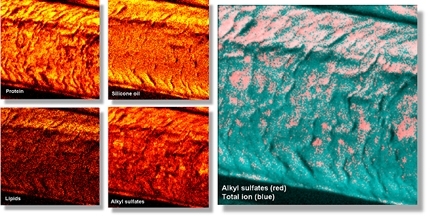Lucideon Investigates Hair Care Products
Modern haircare products include a wide range of shampoos, conditioners, styling products and colorants. The chemistry of each product is complex and formulated to bring a specific cosmetic or medical effect, e.g. cleansing, anti-dandruff, shine, lustre and thickening. For example, a proprietary shampoo may contain cleansing agents (surfactants), conditioners, functional additives, preservatives, aesthetic additives and medically active ingredients.
Increasingly, the development of effective hair treatments relies on a detailed knowledge of the surface chemistry of the hair and the effect of the various ingredients of the formulation on hair structure, e.g. the effects of additives on the surface lipid structure is one area of ongoing investigation. The surface sensitivity and detailed chemical information available from X-ray Photoelectron Spectroscopy (XPS) and Time-of-Flight SIMS (ToFSIMS) are well known and are now routinely applied to hair characterization problems. Although a typical human hair has a diameter of 60µm - 100µm it is now possible to obtain detailed molecular information from single hairs with microscopic detail as a result of advances in ToFSIMS technology.

The challenge
A multinational manufacturer of personal care products commissioned Lucideon to investigate the distribution of key surfactant ingredients following treatment of human hair with a range of formulations.
What we delivered
Lucideon used ToFSIMS analysis in mass spectral and imaging modes to identify the various formulation components on the hair surface. Analysis revealed:
- Protein, detected as CN- and CNO-, from keratin
- Silicon oil (polydimethyl-siloxane - PDMS) and quaternary ammonium compounds from conditioning agents
- Alkyl sulfates from surfactant additives
- Lipids, detected as palmitate, oleate, stearate and 18-methyleicosanoate species, from the hair structure
ToF-SIMS images of a single hair show the distribution of the key species identified above:

Value to the client
From information obtained in the study, the client was able to modify the formulation to obtain optimum coverage of the surfactant and other additive species on the hair surface following washing treatment. This information proved vital in matching the product formulation to the stringent requirements of regulatory authorities in major market areas such as the USA.
